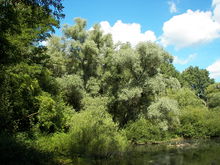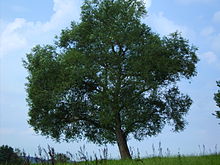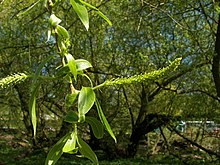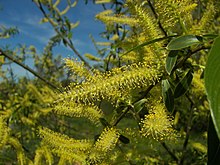Silver willow
| Silver willow | ||||||||||||
|---|---|---|---|---|---|---|---|---|---|---|---|---|

White willow ( Salix alba ), illustration |
||||||||||||
| Systematics | ||||||||||||
|
||||||||||||
| Scientific name | ||||||||||||
| Salix alba | ||||||||||||
| L. |
The white willow ( Salix alba ) is a plant in the genus of willow ( Salix ) from the family of the pasture plants (Salicaceae). The name refers to the silvery, narrow, lanceolate leaves . It is one of the few tree-shaped willows and was tree of the year 1999.
Appearance
As a deciduous tree, the white willow can reach a height of up to 35 meters, it only grows as a shrub in exceptional cases. Willows that are around 200 years old have been found. Younger trees still have a pointed, conical crown ; on the other hand, the crown of older trees appears shapeless. The trunk can reach a diameter of up to 1 meter, which in older trees is characterized by a grayish, deeply furrowed bark. The bark is dark gray with thick, closely spaced ridges. The branches are acute-angled. Young twigs are yellow to (red) brown, short lying hairy and flexible. Older branches are bare. The summer leaves are 5 to 12 inches long. They are narrowly lanceolate with the greatest width in the middle and evenly narrowed on both sides. The leaf margins are finely serrated; the glands sit on the tips of the teeth. The hairiness of the leaves is thin and silky on the upper side, dense and longitudinally aligned on the underside. As a result, the leaves appear silvery shiny and have given rise to the German and botanical species name. The petiole reaches 5 millimeters in length.
The dioecious flowers appear after the leaves shoot from April to May. The male flowers are yellow, the female green and later woolly white. The kittens are up to 7 inches long and cylindrical. The stamens are densely hairy at the base. The ovaries are glabrous, sessile or with a short stalk. The bracts are solid yellow and elongated. The base and the edge are short-haired, bald in the front part. There is only one outer bud scale, one inner bud scale and one pseudo scale are missing (in contrast to Salix - rubens ). The seeds ripen between June and July and have long, white hair that serves as a flight aid.
The number of chromosomes is 2n = 76.
Distribution and location
The white willow is native to all of Europe with the exception of Scandinavia , North Africa and east to Central Asia. In Central Europe it occurs from the plain to middle mountain ranges (mostly up to 850 m). In the Allgäu Alps in Vorarlberg, it rises on a slope near Gatter near Riezlern up to 1150 meters above sea level.
As a kind of warmth-loving light wood, it grows in flooded areas in riverside bushes, in alluvial forests , on backwaters , on streams or lakes. It prefers periodically flooded, nutrient and base-rich, calcareous to moderately acidic, sandy-gravelly clay soils or pure silt soils ( raw soil ). It is a character species of the Salicetum albae from the association Salicion albae.
As a pioneer plant, it also colonizes secondary locations such as ditches, banks of residual water or former extraction points for sand, gravel, clay and loam. The silver willow can also be used as a dump greening, for the recultivation of cultivated areas (soil improvement) or as a windbreak.
ecology
Mighty white willow trees often grow in the floodplains of large rivers. The stocks depend on regular flooding and, together with other types of softwood floodplains, help to mitigate flood events and stabilize the banks. With its extensive root system, the willow can limit erosion . It is very vigorous and has intensive roots. In the youth stage, the growth of the annual shoots can be up to 2 meters. The branches take root very easily when they come into contact with the ground and establish a very strong vegetative reproductive capacity . The seeds germinate quickly.
The heartwood d. H. the inner, no longer water-conducting parts of the wooden body are not protected against rot by tannins and weather quickly. This is why old willow trees are often hollow inside. Such caves serve as shelter for animals or they fill with humus and thus become a flower pot for other plants. The beaver usually builds its residential castles near pastures and uses them as a source of food.
Due to the loss of its biotopes, the white willow has significantly decreased in its population. This fact was a reason to choose this willow as tree of the year 1999.
Pollard willows
Pollard willows are created by regularly cutting the branches back almost to the trunk. The branches were used as wicker for weaving baskets and as wickerwork for the infill of half-timbered houses. Because cutting back the pollarded willows became too laborious or unprofitable in the course of modern agriculture, many polluted willows grew out of the way and collapsed. In the meantime, committed environmentalists have often taken over the pruning of the pollarded willows.
Pests
The tangled braids of the willow are up to 20 cm long, upset shoots in which the leaves are stunted to scales. They are caused by gall mites of the genera Eriophyes , Aceria and Vasates .
Systematics
The silver willow was first published in 1753 by Carl von Linné in Species Plantarum .
Some subspecies or varieties of the white willow are known. The status of the various forms is understood differently:
- Salix alba subsp. alba
- Salix alba subsp. caerulea (Sm.) Rech.f.
- Salix alba subsp. vitellina (L.) Schübl. & G.Martens , also known as colorful willow, yellow willow or yolk willow.
- Salix alba var. Sericea Gaudin .
The colorful willow is an ornamental wood that came from East Asia and was imported into Germany. It is characterized by the yolk-yellow to mennig-red color of the young twigs, which are particularly noticeable in winter. The shoot is red. The leaves are almost bare on the top and only slightly hairy on the underside.
The silver willow and the broken willow ( Salix fragilis ) form the pale willow or high willow ( Salix × rubens cabinet ). The hybrid has red-brown branches. The leaf blade is widest below the center. The bracts are long hairy on the edge and bearded at the tip. A rare hybrid with the almond willow ( Salix triandra ) is the wavy-leaved willow ( Salix × undulata Ehrh. ).
In addition, the white willow forms a hybrid with the real weeping willow ( Salix babylonica L. ) from China , the weeping willow Salix × sepulcralis Simonk. with limp branches.
With pastures of various origins being planted everywhere nowadays, seedlings often have parents of different subspecies. This leads to a certain standardization of the appearing characteristics ( phenotype ), but does not mean genetic impoverishment .
Cultivated forms in horticulture
There are numerous cultivated forms of the white willow that are used in gardening and landscaping:
- 'Liempde': The crown of this large tree, up to 30 meters high, has a narrow, conical shape. The bark is yellowish and later light brown. It is used for planting paths, streets and avenues.
- 'Sericea': This form, also known as 'Argentea', is often found in gardens and parks. The leaves are up to 10 cm long and are shiny silver-white due to the long, white, silky hairs on both leaf sides; this makes the tree conspicuous from afar.
- 'Tristis': This shape, created in France around 1815, is the well-known weeping willow . It is widely grown on bodies of water and in parks. The tree can reach a height of 22 m. The crown of the tree is irregularly broad; the long, thin branches hang limply. The bark is light gray-brown. The twigs are bright yellow in spring and light yellow in summer. The leaves sprout earlier than the type; they are also larger (up to 10 cm in length and 1.5 cm in width). Most of the specimens are male clones; but sometimes female flowers occur in the male catkins. In the trade, the weeping willow can often be found under the false name Salix babylonica .
- Curly willow ( Salix × erythroflexuosa ): Cross of Salix matsudana 'Tortuosa' and Salix alba 'Tristis'.
use
Willow branches and wood
The white willow was often cut as pollard willow . The willow branches were previously used as wicker material. The white-gray wood with a brown core is used less often. It is soft, not very resilient, easy to split and pliable. Cricket bats , prostheses or wooden shoes are usually made from them. It is used more often as firewood or in the paper industry.
Medicinal plant
The bark of the willow contains the pain reliever and antipyretic salicin . In the 12th century Hildegard von Bingen recommended willow bark tea against fever , gout and joint rheumatism . In the 17th century, the bark was used to manufacture medicines against gout and rheumatism.
Cosmetics
In hair care, silver willow is now used to avoid the yellow tinge of older gray, bleached or chlorinated hair.
swell
literature
- Henning Haeupler, Thomas Muer: picture atlas of the fern and flowering plants of Germany . Ed .: Federal Agency for Nature Conservation (= The fern and flowering plants of Germany . Volume 2 ). Eugen Ulmer, Stuttgart (Hohenheim) 2000, ISBN 3-8001-3364-4 .
- Erich Oberdorfer : Plant-sociological excursion flora . With the collaboration of Theo Müller. 6th, revised and expanded edition. Eugen Ulmer, Stuttgart (Hohenheim) 1990, ISBN 3-8001-3454-3 .
- Andreas Rohloff: Biology and ecology of the white willow (Salix alba L.). In: Klaus Höppner (Ed.): Tree of the year 1999 - Silberweide. Landesforstanstalt, Eberswalde; Ministry of Agriculture, Environmental Protection and Regional Planning of the State of Brandenburg, Potsdam 2001, ISBN 3-933352-38-X , pp. 11-18, PDF file.
- Norbert Lagoni: Willow bark as a pharmaceutical raw material - yesterday and today. In: Klaus Höppner (Ed.): Tree of the year 1999 - Silberweide. Landesforstanstalt, Eberswalde; Ministry of Agriculture, Environmental Protection and Regional Planning of the State of Brandenburg, Potsdam 2001, ISBN 3-933352-38-X , pp. 52–57, PDF file.
- Volker Zahner: Beavers and willows - a relationship of mutual benefit? In: Christian Wild (Hrsg.): Contributions to the silver willow. Conference proceedings on the tree of the year 1999. - Reports from the Bavarian State Institute for Forests and Forestry 24. Freising 1999. ( PDF file. )
- M. Bächtiger, E. Trachsel, S. Bilger: Salix alba. In: Urs-Beat Brändli (Ed.): Exercises wood portrait. Winter semester 2003/04. Zurich University of Applied Sciences Wädenswil, Institute for Environment and Natural Resources, Environmental Engineering course, PDF file.
- Margot Spohn, Marianne Golte-Bechtle: What is blooming there? The encyclopedia: over 1000 flowering plants from Central Europe. Kosmos, Stuttgart 2005, ISBN 3-440-10326-9 .
Individual evidence
- ↑ a b Erich Oberdorfer : Plant-sociological excursion flora for Germany and neighboring areas . 8th edition. Verlag Eugen Ulmer, Stuttgart 2001, ISBN 3-8001-3131-5 . Page 305.
- ↑ Erhard Dörr, Wolfgang Lippert : Flora of the Allgäu and its surroundings. Volume 1, IHW, Eching 2001, ISBN 3-930167-50-6 , p. 408.
- ↑ a b c Ruprecht Düll , Herfried Kutzelnigg : Pocket dictionary of plants in Germany and neighboring countries. The most common Central European species in portrait . 7th, corrected and enlarged edition. Quelle & Meyer, Wiebelsheim 2011, ISBN 978-3-494-01424-1 , p. 686-687 .
- ↑ Carl von Linné: Species Plantarum. Volume 2, Impensis Laurentii Salvii, Holmiae 1753, p. 1021, digitized
- ^ Germplasm Resources Information Network (GRIN)
- ↑ H.-D. Warda: The great book of garden and landscape trees. Bruns plants, Bad Zwischenahn 2001, ISBN 3-9803833-3-4 .
Web links
- Klaus Höppner (Ed.): Tree of the year 1999 - Silberweide.
- Christian Wild (Ed.): Contributions to the silver willow. Conference proceedings on the tree of the year 1999. - Reports from the Bavarian State Institute for Forests and Forestry . (Extensive compendium on white willow)
- Silver willow. In: FloraWeb.de.
- Silver willow . In: BiolFlor, the database of biological-ecological characteristics of the flora of Germany.
- Profile and distribution map for Bavaria . In: Botanical Information Hub of Bavaria .
- Salix alba L. In: Info Flora , the national data and information center for Swiss flora .
- Thomas Meyer: Data sheet with identification key and photos at Flora-de: Flora von Deutschland (old name of the website: Flowers in Swabia )











